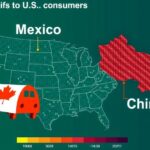Understanding Trump’s Tariffs on Canada, Mexico, and China
President Trump imposed tariffs on Canada, Mexico, and China, aiming to address illegal immigration and fentanyl production. These actions led to retaliatory tariffs from Canada and Mexico, sparking debates on trade relations.
U.S. President Donald Trump implemented tariffs on imports from Canada and Mexico, prompting both countries to enact retaliatory measures against U.S. goods. The rationale behind these tariffs was to address issues of illegal immigration and combat the trafficking of fentanyl. In a related move, Trump also imposed a 10% tariff on Chinese imports, aiming to curtail the production of this substance. These trade policies have sparked significant discussions regarding their implications for international relations and trade practices.
Tariffs serve as tools employed by governments to protect domestic industries by increasing the costs of foreign imports. Such policies can lead to trade wars, where countries continuously impose tariffs on each other’s products. In Trump’s case, these tariffs were largely justified as means to protect American interests related to immigration and drug trafficking. The impact of these tariffs has been felt widely across various sectors, affecting both consumers and producers in the United States and abroad.
In summary, President Trump’s tariffs targeting Canada, Mexico, and China have been described as measures to combat illegal immigration and fentanyl production. The retaliatory responses from Canada and Mexico reflect the complexities of international trade relations and underscore the challenges faced by U.S. exporters. These developments highlight the need for careful consideration of trade policies that can have far-reaching economic consequences.
Original Source: apnews.com








Post Comment